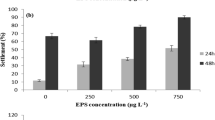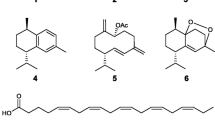Abstract
Films of bacteria on solid substrata can positively or negatively influence the attachment of marine invertebrate larvae. Effects of marine bacteria on the attachment of cypris larvae of the barnacle Balanus amphitrite Darwin were examined in the laboratory. Bacteria, grown to mid-exponential phase and allowed to adsorb irreversibly to polystyrene petri dishes, attached in densities of 107 cells cm-2. Assays (22h) were used to compare the effects of adsorbed cells of 18 different bacterial species on larval barnacle attachment. Most of the adsorbed bacteria either inhibited or had no effect on larval attachment compared to clean surfaces. Experiments testing the effect of larval age on barnacle attachment were conducted with six species of bacteria and showed that older larvae attached in higher percentages to clean surfaces and that bacterial films generally inhibited larval attaschment. Both the species of bacteria and the in situ age of the adsorbed bacteria affected barnacle attachment response: older films of Deleya (Pseudomonas) marina were more inhibitory. Bacterial extracellular materials may be involved in the inhibitory process.
Similar content being viewed by others
Literature cited
Baumann, P., Baumann, L., Mandel, M. (1971). Taxonomy of marine bacteria: the genus Beneckea. J. Bact. 107: 268–294
Baumann, L., Baumann, P., Mandel, M., Allen, R. D. (1972). Taxonomy of aerobic marine eubacteria. J. Bact. 110: 402–429
Baumann, L., Bowditch, R. D., Baumann, P. (1983). Description of Deleya gen. nov. created to accomodate the marine species Acaligenes aestus, A. pacificus, A. cupidus, A. venustus, and Pseudomonas marina. Int. J. Syst. Bact. 33: 793–802
Bishop, M. W. H. (1950). Distribution of Balanus amphitrite Darwin var. denticulata Broch. Nature, Lond. 165: 409–410
Brancato, M. S., Woollacott, R. M. (1982). Effect of microbial films on settlement of bryozoan larvae (Bugula simplex, B. stolonifera, and B. turrita). Mar. Biol. 71: 51–56
Branscomb, E. S., Rittschof, D. (1984). An investigation of low frequency sound waves as a means of inhibiting barnacle settlement. J. exp. mar. Biol. Ecol. 79: 149–154
Cobet, A. B., Wirsen, C. Jr. Jones, G. E. (1970). The effect of nickel on a marine bacterium, Arthrobacter marinus sp. nov. J. gen. Microbiol. 62: 159–169
Costlow, J. D. Jr. Bookhout, C. G. (1958). Larval development of Balanus amphitrite var. denticulata Broch reared in the laboratory. Biol. Bull. mar. biol. Lab., Woods Hole 114: 284–295
Crisp, D. J. (1984). Overview of research on marine invertebrate larvae, 1940–1980. In: Costlow, J. D., Tipper, R. C. (eds.) Marine biodeterioration: an interdisciplinary study. Naval Institute Press, Annapolis, p. 103–126
Crisp, D. J., Meadows, P. S. (1962). The chemical basis of gregariousness in cirripedes. Proc. R. Soc. Lond. Ser. B 156: 500–520
Crisp, D. J., Meadows, P. S. (1962). Adsorbed layers: the stimulus to settlement in barnacles. Proc. R. Soc. Lond. Ser. B 158: 364–387
Crisp, D. J., Molesworth, A. H. N. (1951). Habitat of Balanus amphitrite var. denticulata in Britain. Nature, Lond. 167: 489–490
Crisp, D. J., Walker, G., Young, G. A., Yule, A. B. (1985). Adhesion and substrate choice in mussel and barnacles. J. Coll. Interface Sci. 104: 40–50
Daley, R. J., Hobbie, J. E. (1975). Direct counts of aquatic bacteria by a modified epifluorescence technique. Limnol. Oceanogr. 20: 875–882
Fletcher, M. (1977). The effects of culture concentration and age, time, and temperature on bacterial attachment to polystyrene. Can. J. Microbiol. 23: 1–6
Fletcher, M., Loeb, G. I. (1979). Influence of substratum characteristics on the attachment of a marine pseudomonas to solid surfaces. Appl. envir. Microbiol. 37: 67–72
Fletcher, M. Marshall, K. C. (1982). Are solid surfaces of ecological significance to aquatic bacteria? Adv. microb. Ecol. 6: 199–236
Gherna, R. L. (1981). Preservation. In: Gerhard, P., Murray, R. G. E., Costilow, R. N., Nester, E. W., Wood, W. A., Krieg, N. R., Phillips, G. B. (eds.) Manual of methods for general microbiology. Washington, D.C., Am. Soc. Microbiol. p. 208–217
Harris, J. E. (1946). Report on anti-fouling research, 1942–1944. J. Iron Steel Inst. 154: 297–334
Hudon, C., Bourget, E., Legendre, P. (1983) An integrated study of the factors influencing the choice of the settling site of Balanus crenatus cyprid larvae. Can. J. Fish. aquat. Sci. 40: 1186–1194
Kirchman, D., Graham, S., Reish, D., Mitchell, R. (1982a). Bacteria induce settlement and metamorphosis of Janua (Dexiospira) brasiliensis Grube (Polychaeta: Spirorbidae). J. exp. mar. Biol. Ecol. 56: 153–163
Kirchman, D., Graham, S., Reish, D., Mitchell, R. (1982b). Lectins may mediate in the settlement and metamorphosis of Janua (Dexiospira) brasiliensis Grube (Polychaeta: Spirorbidae). Mar. Biol. Lett. 3: 131–142
Knight-Jones, E. W. (1951). Gregariousness and some other aspects of the setting behaviour of Spirorbis. J. mar. biol. Ass. U. K. 30: 201–222
Larman, V. N., Gabbott, P. A., East, J. (1982). Physico-chemical properties of the settlement factor proteins from the barnacle Balanus balanoides. Comp. Biochem. Physiol. 72B: 329–338
Lee, J. V., Shread, P., Furniss, A. L., Bryant, T. N. (1981). Taxonomy and description of Vibrio fluvialis sp. nov. (Synonym Group F Vibrios, Group EF6). J. appl. Bact. 50: 73–94
Leifson, E. (1963). Determination of carbohydrate metabolism of marine bacteria. J. Bact. 85: 1183–1184
Lewis, C. A. (1978). A review of substratum selection in free-living and symbiotic cirripeds. In: Chia, F. S., Rice, M. E. (eds.) Settlement and metamorphosis of marine invertebrate larvae. Elsevier, New York, p. 207–218
Marshall, K. C. (1976). Interfaces in microbial ecology. Harvard University Press, Cambridge, 156 pp.
Marshall, K. C., Stout, R., Mitchell, R. (1971). Mechanism of the initial events in the sorption of marine bacteria to surfaces. J. gen. Microbiol. 68: 337–348
Meadows, P. S., Williams, G. B. (1963). Settlement of Spirorbis borealis Daudin larvae on surfaces bearing microorganisms. Nature, Lond. 198: 610–611
Mihm, J. W., Banta, W. C., Loeb, G. I. (1981). Effects of adsorbed organic and primary fouling films on bryozoan settlement. J. exp. mar. Biol. Ecol. 54: 167–179
Mitchell, R., Kirchman, D. (1984). The microbial ecology of marine surfaces. In: Costlow, J. D., Tipper, R. C. (ed.) Marine biodeterioration: an interdisciplinary study. Naval Institute Press, Annapolis, p. 49–56
Muller, W. A. (1973). Induction of metamorphosis by bacteria and ions in the planulae of Hydractinia echinata; an approach to the mode of action. In: Tokioka, T., Nishimura, S. (ed.) Proc. 2nd Int. Symp. on Cnidaria (Recent trends in coelenterate biology). Publ. Seto Mar. Biol. Lab., no. 20, pp. 195–208
Neumann, R. (1979). Bacterial induction of settlement and metamorphosis in the planula larvae of Cassiopea andromeda (Cnidaria: Scyphozoa, Rhizostomeae). Mar. Ecol. Prog. Ser. 1: 21–28
Nott, J. A., Foster, B. A. (1969). On the structure of the antennular attachment organ of the cypris larva of Balanus balanoides (L.). Philas. Trans. R. Soc. Lond. Ser. B 256: 115–134
Reichelt, J. L., Baumann, P., Baumann, L. (1976) Study of genetic relationships among marine species of the genera Beneckea and Photobacterium by means of in vitro DNA/DNA hybridization. Arch. Microbiol. 110: 101–120
Rittschof, D. (1985). Oyster drills and the frontiers of chemical ecology: unsettling ideas. Am. malacol. Bull., Spec. Ed. No. 1: 111–116
Rittschof, D., Branscomb, E. S., Costlow, J. D. (1984). Settlement and behavior in relation to flow and surface in larval barnacles, Balanus amphitrite Darwin. J. exp. mar. Biol. Ecol. 82: 131–146
Rittschof, D., Hooper, I. R., Branscomb, E. S., Costlow, J. D. (1985). Inhibition of barnacle settlement and behavior by natural products from whip corals, Leptogorgia virgulata (Lamarck 1815). J. Chem. Ecol. 11: 551–563
Rittschof, D., Maki, J., Mitchell, R., Costlow, J. D. (1986). Ion and neuropharmacological studies of barnacle settlement. Neth. J. Sea Res. 20: 269–275
Sakazaki, R. (1968). Proposal of Vibrio alginolyticus for the biotype 2 of Vibrio parahaemolyticus. Japan. J. Med. Sci. Biol. 21: 359–362
Schmahl, G. (1985). Bacterially induced stolon settlement in the Scyphopolyps of Aurelia aurita (Cnidaria, Scyphozoa). Helgoländer Meeresunters. 39: 33–42
Seber, G. A. F. (1977). Linear regression analysis. John Wiley and Sons, New York
Sutherland, I. W. (1983). Microbial exopolysaccharides — their role in microbial adhesion in sequeous system. CRC Crit. Rev. Microbiol. 10: 173–201
Tighe-Ford, D. J., Power, M. J. D., Vaile, D. C. (1970). Laboratory rearing of barnacle larvae for antifouling research. Helgoländer wiss. Meeresunters. 20: 393–405
Visscher, J. P. (1928). Nature and extent of fouling of ships' bottoms. Bull. U.S. Bur. Fish. 43: 193–252
Walker, G., Yule, A. B. (1984). Temporary adhesion of the barnacle cyprid: the existence of an antennular adhesive secretion. J. mar. biol. Ass. U. K. 64: 679–686
Weiner, R. M., Segall, A. M., Colwell, R. R. (1985). Characterization of a marine bacterium associated with Crassostrea virginica (the Eastern Oyster). Appl. Envir. Microbiol. 49: 83–90
Yaphe, W. (1957). The use of agarase from Pseudomonas atlantica in the identification of agar in marine algae (Rhodophyceae). Can. J. Microbiol. 3: 987–993
Yule, A. B., Crisp, D. J. (1983). Adhesion of cypris larvae of the barnacle, Balanus balanoides, to clean and arthropodin treated surfaces. J. mar. biol. Ass. U. K. 63: 261–271
Zar, J. H. (1984): Biostatistical analysis, 2nd ed., 718 pp. Prentice-Hall, Inc., Englewood Cliffs
Zobell, C. E., Upham, H. C. (1944). A list of marine bacteria including descriptions of sixty new species. Bull. Scripps Inst. Oceanog. 5: 239–292
Author information
Authors and Affiliations
Additional information
Communicated by J. M. Lawrence, Tampa
Rights and permissions
About this article
Cite this article
Maki, J.S., Rittschof, D., Costlow, J.D. et al. Inhibition of attachment of larval barnacles, Balanus amphitrite, by bacterial surface films. Mar. Biol. 97, 199–206 (1988). https://doi.org/10.1007/BF00391303
Accepted:
Issue Date:
DOI: https://doi.org/10.1007/BF00391303




